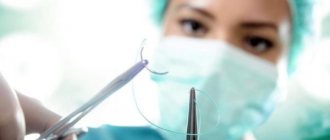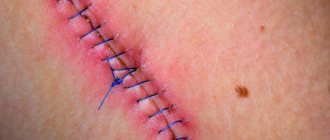A beautiful oval face, clear contours - all this is created by the chin. Mentoplasty is rarely discussed, but this plastic surgery is very popular among celebrities, both men and women. We will understand all the nuances of chin correction together with a plastic surgeon.
Otari Gogiberidze
, leading plastic surgeon, founder of the Beauty Time clinic
Mentoplasty, or chin surgery, is not often discussed in the media, but this operation is incredibly in demand. It is the chin that influences the shape of the face, sets the tone for the entire appearance and can either decorate or detract from the appearance. The chin receives a lot of attention in physiognomy - the theory of the connection between facial features and a person’s character. A prominent, powerful chin is considered a sign of masculinity and charisma in men; graceful, fine lines in this area are characteristic of women.
But nature does not always endow us with desirable facial features. A heavy chin in women causes complexes and uncertainty; a chin that is not large enough can make a young man feel shy. Often a small change in the chin can change the entire impression of a person.
Advantages and disadvantages
You can make artificial dimples on your cheeks using cosmetics, piercings and special exercises. An effective method is the surgical method. Before plastic surgery, you need to familiarize yourself with its advantages and disadvantages.
| Advantages | Flaws |
| Short duration - about 60 minutes | With age, artificial dimples become more pronounced, which leads to the appearance of deep wrinkles |
| There is no need to administer drugs for general anesthesia | The result of the procedure is irreversible: after a dimplectomy, it is impossible to completely return to the previous appearance |
| Recovery takes a short period of time | There is a rehabilitation period with its limitations |
| The results last a lifetime | The operation requires adjustments to the patient’s usual lifestyle, both before and after the operation. |
| It is possible to perform the operation on both thin and obese patients | Pain may occur when moving the facial muscles (disappears over time) |
| No postoperative scars are observed | After the procedure, the face swells |
| The result is noticeable immediately after the procedure | In some cases, bruises appear |
Positive and negative aspects depend on the individual characteristics of the person. Now cosmetology centers are equipped with a high-quality arsenal of medications, medical equipment and a variety of effective techniques that are selected strictly for the patient. All this helps reduce the risk of further complications.
Photos before and after
Tags: plastic surgery
Market Analytics
- Global cosmetics market 2022: an unprecedented test for the global cosmetics industry
- Top 10 Cosmetic Research and Development of 2022
- 2020 in the beauty industry – innovation without borders
Convenient search for beauty salons on our website
Beauty salons in Moscow Beauty salons in St. Petersburg Beauty salons in Ekaterinburg Beauty salons in Novosibirsk
Latest blog posts on our website
- Naturecream / Properties of the “Sunny” oil itself
- Naturecream / “Sugar” wrinkles - or what glycation can do
- Naturecream / Esterified oils
- Naturecream / Arnica - the magical plant of alchemists
- Naturecream / Tremella Extract - Snow Mushroom Detox for Skin
- Prostye-sovety / How to visually enlarge your lips with makeup
- Naturecream / Apricot kernel oil for face
- Naturecream / MATRIXYL3000 - the best skin elasticity stimulator
- Naturecream / SPF in Natural Oils
- Naturecream / Geranium (Pelargonium) oil for skin health and beauty
Latest forum topics on our website
- Natalya / How to properly make a gelatin mask?
- Mrs._Smith / Badly sunburned! What to do?((
- Ice / Is it necessary to combine fitness classes with a diet?
- Antonova / What can be used for hair loss?
- Radio operatorKat / Who was on a protein diet?
Reviews about
the dimple procedure: how to do it, dimpleectomy surgery [Leave a review]
Leave your feedback about this procedure (it will appear on this page after moderation)
In this form, describe only
your personal
experience of undergoing the procedure.
In order to leave a comment regarding the content of the article, use another form - in the “comments” block at the bottom of the page.
Other articles in this section
| Non-surgical thread lifting Aging and fading of facial skin is an irreversible process. But, thanks to the methods of modern cosmetology, it can be significantly corrected. One of these methods is lifting - tightening the skin of the face (from the English “lift” - to raise). Lifting can be surgical - this is a classic plastic surgery that tightens sagging skin, or non-surgical, the popularity of which is rapidly gaining momentum. |
| Contour plastic Contour plastic is an injection rejuvenation of the face with the aim of eliminating wrinkles and improving skin texture by introducing drugs (fillers), usually based on hyaluronic acid, into the middle layers of the skin to fill in missing volumes and folds. Most often, this technique is used to eliminate nasolabial folds, correct the shape of the lips, the shape of the face and cheekbones. |
| Botox injections: is Botox harmful to the face? In this article we will talk about Botox injections: is Botox harmful, how does botulinum toxin work and what consequences may arise from its use. |
| Facial skin tightening (rhytidectomy) Facial skin tightening is a comprehensive approach to getting rid of wrinkles and sagging skin caused by aging. Surgeries vary in the degree of intervention, ranging from minimal, so-called “lunch-time lifting”, to longer and more complex procedures. |
| Hyaluronic acid in the lips Hyaluronic acid is injected into the lips in almost every beauty salon or cosmetology clinic - this is one of the most popular procedures among women of different age categories. The introduction of hyaluronic acid into the lips allows you to maintain youth and moisture, as well as add volume to the lips and correct their shape. |
| Facial implants (Chin and cheek implants) Facial implants are designed to create a clearer facial contour and rejuvenate it. There are implants of different shapes and sizes to restore a beautiful facial contour or proportions. They can be used to increase the size of the chin and jaw, highlight the cheekbones and smooth the infraorbital area. |
| Lip augmentation and correction (cheiloplasty) Full, plump lips are often considered a sign of good health, youth and beauty. If you were born with thin lips, or they are shrinking as a result of the natural aging process, there are many ways to enhance them. Plastic surgery using natural or synthetic fillers will help you look the way you want for several months. |
| Ear plastic surgery (otoplasty) Ear plastic surgery (otoplasty) or ear correction is an aesthetic procedure that changes the size, position or proportions of the ear. The result of the correction depends on the changes you want to make to your appearance. In general, plastic surgery improves self-confidence, especially in children and adolescents. With the help of otoplasty, you can press your ears back to your head if they are protruding; adjust the level if one ear is higher than the other; make the ears symmetrical, if one ear is larger or smaller than the other, and also reduce/enlarge both ears. |
| Hair Transplant Alopecia, hair loss or baldness, is a common problem that affects both women and men. Its manifestation can be triggered by stress, illness, certain medications and heredity. While some factors are temporary, many lead to permanent hair loss, which can affect a person's self-confidence. Hair transplant is intended to help people suffering from baldness and hair thinning. |
| Circular facelift Every woman always strives to remain beautiful and young. Unfortunately, over time, age-related changes become more and more noticeable - wrinkles appear, the oval of the face becomes blurred, and the skin becomes flabby. All these factors negatively affect your appearance. But there is a way out - a circular facelift (another name for the procedure is rhytidectomy). With its help, you can achieve amazing results - many women who have undergone surgery look 15-20 years younger. The effect of the operation lasts for a long time. |
Indications
There are no indications for dimplectomy other than the desire of patients to change their appearance. The procedure has no age restrictions and is performed on any skin type.
The main reasons for the operation are:
- the desire to add expressiveness and beauty to round cheeks;
- the need to adjust the cheek line;
- the desire to highlight the cheekbone line;
- age-related decrease in skin turgor.
A surgeon can make dimples on the cheeks if there are no contraindications to the procedure.
Don't miss the most popular article in the section: Cannula - what it is, how it is used in cosmetology and medicine.
Contraindications
There are a number of contraindications for the procedure:
- diseases of the heart and blood vessels that are in the acute phase (complications may occur);
- diseases and tumors caused by viruses;
- pregnancy and lactation;
- chronic diseases that are in the acute stage (provoking severe complications);
- pathologies of the circulatory system leading to deterioration of coagulation (for example, hemophilia - provokes large blood loss during surgery);
- general ailments;
- oncology (the presence of benign tumors is also a reason for refusing surgery);
- diseases of the central nervous system;
- mental disorders;
- epilepsy;
- diabetes mellitus (decompensated and in the stage of decompensation can provoke ketoacidotic coma; compensated diabetes mellitus is assessed as a relative contraindication, so some surgeons will be able to perform the operation);
- allergic reactions to medications (causes of anaphylactic shock and death during invasion);
- long history of smoking (leads to disruption of natural tissue regeneration, the rehabilitation period is delayed by 2-3 weeks);
- menstruation (may increase bleeding during surgery);
- severe obesity of 3-4 degrees;
- elderly age;
- children under 18 years of age.
What examinations need to be completed
If the clinic performs a dimplectomy under general anesthesia, the following tests and examinations must be taken and completed:
- examination by a general practitioner (based on the results of a clinical examination and laboratory and instrumental examination data, it determines the general condition of the patient and his readiness to undergo the required amount of surgical intervention) (cost about 1,800 rubles);
- coagulogram (about 1305 rub.);
- procedure for determining the patient’s blood type and Rh factor (about 700 rubles);
- blood test for AIDS, syphilis, hepatitis B and C (cost about 442 rubles);
- chest x-ray (bring with you if the procedure was performed within the last year) (about 1,600 rubles);
- clinical blood test, ESR (about 315 rubles);
- detailed biochemical blood test (determining the content and amount of sugar, ALT, AST, bilirubin, creatinine, urea, total protein) (about 5920 rubles);
- urine analysis with sediment microscopy (range 320-640 rubles);
- ECG (about 530 rubles).
Cheek dimples can be made using surgery under local anesthesia.
List of tests:
- clinical blood test (necessary to determine the number of platelets and clotting time) (about 315 rubles);
- blood test for AIDS, syphilis, hepatitis B and C (about 442 rubles);
- ECG (within 530 rubles);
- biochemical blood test (determination of sugar, ALT, AST, bilirubin and creatinine) (about 5920 rubles);
- general urine analysis (range 320-640 rubles);
- examination by a general practitioner (about 1,800 rubles).
Tests will be valid for 14 days after they are completed.
Preparing for surgery
The desired result depends not only on the professionalism of the surgeon, the equipment of the clinic with special medical equipment, but also on the correct preparation and psychological attitude of the patient.
The following rules must be followed:
- refrain from taking medications (for example, drugs containing acetylsalicylic acid, anticoagulants, hormones, vitamins E and C affect the nature of blood flow). Do not take them 2 weeks before surgery. Take medications prescribed by your doctor to correct blood pressure, cholesterol and sugar;
- quit nicotine 14 days before the procedure;
- stop drinking alcoholic beverages a week before the dimpleectomy (they promote bleeding);
- cook food with little salt;
- exclude spicy foods and caffeine (this prevents swelling after surgery);
- reduce the consumption of meat, fresh vegetables and fruits, as well as vitamins;
- stop visiting the solarium;
- start a proper rest.
The evening before the dimpleectomy, have a light dinner before 18:00. After midnight, refrain from constant drinking. Cleanse the body of waste and toxins with an enema. Take mild sedatives. Have a good rest and sleep before the procedure.
On the day of surgery, stop eating and drinking. In the morning, take a hot shower, wash your hair and apply an antiseptic to the area of the procedure. Wear the most comfortable clothes, wash off your manicure and makeup, remove jewelry and discard contact lenses.
It is worth thinking in advance about the method of returning home. Ask loved ones for help for a while, as some drugs reduce concentration and the speed of metabolic reactions. Before the operation, it is important to discuss with the surgeon where the dimples will be located, what their size and depth are.
Don’t miss the most popular article in the section: Vera Alentova after plastic surgery - the latest photos, what operations were performed, how the star has changed.
Which celebrities had mentoplasty?
Megan Fox
Source: @meganfox
Megan has a slightly different problem: she does not accept her appearance before the upgrade. 13 years have passed since the release of the first part of Transformers, and since then the actress has changed dramatically. She removed Bisha's lumps and performed rhinoplasty and mentoplasty.
Robert Pattison
Source: still from the film
The actor resorted to mentoplasty due to congenital asymmetry of the chin. To make his facial features more masculine and brutal, the actor slightly sharpened the contour of the lower part and got rid of uneven lines.
Procedure
An experienced surgeon can make dimples on the cheeks by performing the following sequence of actions:
- a special marker marks the area where the depression will be located in the future;
- an injection is given with an anesthetic for local anesthesia (if the patient wishes and the doctor’s indications, the dimplectomy procedure can be performed under general anesthesia);
- A small incision is made inside the cheek with a surgical instrument;
- fat layers are removed at the incision site;
- The treated area is stitched and tightened with surgical silk, forming a dimple.
The procedure lasts from 35 minutes to 60 minutes. After it, there is no need for the patient to stay in the hospital; he can immediately go home.
Recovery after
Recovery after a dimpleectomy will take from 2-3 weeks to 1 month. The patient will experience swelling for some time. There will be pain, which can be relieved with painkillers. After 2-3 days, moderate pain will remain, noticeably increasing in the operated area when moving or touching it.
Attacks of nausea are possible. Their appearance depends on the duration of local and general anesthesia. Side effects when taking analgesics are minimal, but sometimes people experience them. The face after surgery will be susceptible to swelling. The peak occurs on days 2-3, after which a decline is observed. After 8 days, the skin smooths out and tightens tighter than usual.
After 14 days, only small swelling areas are visible. To speed up regenerative processes after surgery, sleep on thick pillows for 6-7 days. This will help reduce swelling. Ice and cold water also help. Surgeons recommend cooling the intervention area on the 1st day of rehabilitation. Herbal medicines, ointments and physiotherapy may be prescribed.
Important physiotherapeutic procedures are:
- microcurrents (exposure to the wound with weak electrical impulses is necessary to restore the functioning of skin receptors and improve blood circulation; they restore the previous innervation);
- phonophoresis (medicine is applied to the skin, then ultrasound treatment of the damaged area is carried out; the procedure is painless, quickly relieves swelling and bruises);
- darsonval (stimulates good blood movement through the vessels, quickly restores skin sensitivity, relieves swelling);
- ultrasound (acts on capillary walls, improves blood circulation, relieves swelling);
- laser treatment (improves the functioning of skin cells, accelerates the regeneration of soft tissues, prevents the appearance of scars).
The most common ointments for scars:
- Kelofibrase (spread a thick layer of the product on the damaged area 2-4 times a day, average cost 1,600 rubles);
- Zeraderm ultra (apply 3 times a day, product cost about 2100 rubles);
- ScarGuard MD (use 2 times a day for 2-3 months, the drug is absorbed in a few seconds, is felt on the skin for about 20 minutes, price - about 6100 rubles);
- Fermenkol (apply on a napkin or handkerchief and apply to the affected area, price varies from 600 to 1000 rubles);
- Contractubex (apply to dimples 3 times a day, cost about 500-900 rubles);
- Clearvin (smear the wound 4 times a day, cost about 200 rubles);
- Dermatix (apply a thin layer, do not rub in, apply 2 times a day, price – from 1300 rubles);
- Solcoseryl (smear the wound 3 times a day, cost 350-450 rubles);
- Keratan (apply 3-4 times a day, cost about 900 rubles);
- Ichthyol ointment (use the medicine 2 times a day, you can buy it for 150 rubles);
- Madecassol (apply 3 times a day, cost ranges from 150 to 800 rubles).
Edema can be treated with diuretic folk remedies. For this purpose, juices, decoctions, herbal teas and infusions are used.
These are the recipes:
- take 2 cucumbers, 2 carrots and 0.5 lemon, squeeze the juice out of the products to form 300 ml of each, mix all the ingredients and pour a small amount of clean water, drink 3 times a day;
- stock up on a couple of peppermint branches, pour hot water over them, let the product brew in a dark place until it cools down, drink 2 times a day in small sips;
- chop parsley, 1 tbsp. raw materials, pour 0.5 liters of boiling water, leave the broth for half a day, strain through a gauze bandage, take 1 tbsp. 3 times a day;
- 1 tbsp. pour boiling water over corn silk and strain after 10 minutes, drink the drink 3 times a day;
- 1 tbsp. hawthorn, pour 1 liter of hot water, leave to infuse for 2 minutes, drink 1/3 cup 3 times a day.
A noticeable mark after the procedure for the formation of dimples on the cheeks is bruising. This is considered normal, since a small amount of blood accumulates under the epithelium. Bruises are observed for 2-3 weeks, after initial healing of the wounds they disappear. If the hematoma lasts for more than 30 days, then this is considered a complication.
The number of bruises is influenced by the doctor’s professionalism and the patient’s skin type. On day 1 of rehabilitation, take aspirin and other medications with acetylsalicylic acid to avoid thinning the blood and increasing the size of bruises. You can hide the marks of a dimplectomy with cosmetics.
For up to 1 week, you should eat only soft and easily chewable foods. Before breakfast, lunch and dinner, treat the oral cavity with an antiseptic to avoid the penetration of pathogenic microorganisms into the wound. In the morning, brush your teeth with care, trying not to touch the damaged areas of your cheeks.
You can take a shower after surgery after 4-6 days. After 2.5 weeks, you can take a hot bath. For 30 days, cancel trips to the sauna and bathhouse. Avoid exposing the damaged area to sunlight; it can cause pigmentation, which will make the seams more noticeable.
Don't miss the most popular article in the section: How and why ribs are removed - effectiveness, photos before and after surgery.
Rehabilitation
The rehabilitation period lasts from 2 weeks to 1 month.
After surgery, you may experience some discomfort and pain during the first week. To relieve this condition, you can take painkillers, such as paracetamol or ibuprofen.
You need to rinse your mouth with antiseptic solutions and/or herbal infusions of chamomile, sage, oak bark throughout the day and always after eating.
You need to brush your teeth carefully so as not to injure the wound surface. Preference should be given to soft, warm, grated food. For the first 2-3 days, you can eat food from baby jars or make yourself liquid porridge.
Your doctor may prescribe antibiotics to prevent the wound from becoming infected.
When should you see a doctor?
All suture material used in the operation is self-absorbing, so there is no need to remove the sutures. You will need to visit your doctor for follow-up 3 days, 1 week and 3 months after surgery.
How long will the results last?
The result of the operation is visible immediately after the procedure. In this case, the dimples will be visible for 1-2 weeks both when smiling and in a relaxed state. After complete muscle recovery, they will appear only when a person laughs.
Dimples on the cheeks - photos before and after surgery. The result is visible immediately.
Over time, the effect may disappear as the skin loses its elasticity and sags. If you want to remove dimples, reconstructive surgery will help you do this.
Dimples
Cheek dimples are a genetic defect in which a separate bundle of the zygomaticus major muscle (lat. m. zygomaticus major) is separated and attached to the dermis, and thus, when the muscle is tense, a depression is formed, that is, the muscle bundle pulls part of the skin of the cheek along with it. This is most noticeable when smiling and on chubby cheeks, since the fat layer is more pronounced there.
This structural feature of the facial muscles does not affect their work in any way, but creates a cute, childish facial expression that is attractive. This anomaly is transmitted genetically and has a dominant nature, that is, if your parents have dimples, you will have them.
Society has a positive attitude towards those with dimples. They are called "angel's kiss" or "sign of happiness." It is believed that those with this defect are more successful and happy people. Dimples on the cheeks give the face a more youthful appearance. They can be of any shape, asymmetrical and even only on one cheek. With age, dimples may disappear, this is due to thinning of the fat layer and stretching of the muscles.
Those who were not born with dimples can have a simple dimpleectomy surgery.
Possible complications
You can make dimples on your cheeks quickly and inexpensively. Cosmetologists claim that the risk of complications is negligible.
Only if the recommendations are not followed may the following appear:
- long-lasting swelling;
- volumetric hematomas and bruises;
- infection by pathogenic microorganisms;
- numbness in the cheek area;
- the appearance of asymmetry of the depressions or their different depths;
- formation of wrinkles;
- formation of an unnatural depression.
Due to the individual characteristics of scar formation, dimples may be placed asymmetrically, and their shape will not be similar to the desired one. This can easily be corrected with additional surgery.
The operation, which makes it possible to create dimples on women's cheeks, is extremely popular. Nowadays there are many plastic surgery clinics. It is important to approach the selection of a cosmetology center and a doctor responsibly so that the result always pleases the patient.
Article design: Oleg Lozinsky
Exercises for dimples
There is another way to create dimples without surgery.
It is long-term, slow, and, unfortunately, ineffective. If the possibility of being left without results does not upset you, you can resort to physical exercise.
This complex is aimed at stimulating the work of the facial muscles.
Each exercise must be repeated 15 times in 2 approaches:
- Pull your cheeks inward , closing your lips together like a duck. Tighten your facial muscles. The teeth should be relaxed and not squeeze the cheeks.
- Smile widely, pursing your lips. Press on the places where the dimples should be with the pads of your index fingers.
- Feel the place where your cheeks fall most. Press on them with your fingers and slightly pull the skin back. Try smiling widely.
- Take turns lifting the corners of your lips upward.
- as often as possible to the areas where the dimples form. The lips should be tense.
All these exercises should be performed regularly and systematically. To do everything correctly and clearly, look at yourself in the mirror.
Over time, your facial muscles will become toned, and small dimples will form on your cheeks.
https://www.youtube.com/watch?v=d3OZuSyKdlY











